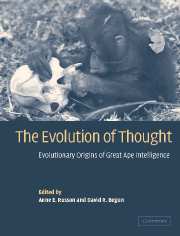Book contents
- Frontmatter
- Contents
- List of Contributors
- Preface
- 1 Evolutionary reconstructions of great ape intelligence
- 2 Enhanced cognitive capacity as a contingent fact of hominid phylogeny
- PART I COGNITION IN LIVING GREAT APES
- PART II MODERN GREAT APE ADAPTATION
- PART III FOSSIL GREAT APE ADAPTATIONS
- Introduction
- 13 Paleoenvironments and the evolution of adaptability in great apes
- 14 Cranial evidence of the evolution of intelligence in fossil apes
- 15 Life history and cognitive evolution in the apes
- 16 Fossil hominoid diets, extractive foraging, and the origins of great ape intelligence
- 17 Paleontology, terrestriality, and the intelligence of great apes
- 18 Body size and intelligence in hominoid evolution
- Part IV INTEGRATION
- Author index
- Species index
- Subject index
14 - Cranial evidence of the evolution of intelligence in fossil apes
Published online by Cambridge University Press: 20 August 2009
- Frontmatter
- Contents
- List of Contributors
- Preface
- 1 Evolutionary reconstructions of great ape intelligence
- 2 Enhanced cognitive capacity as a contingent fact of hominid phylogeny
- PART I COGNITION IN LIVING GREAT APES
- PART II MODERN GREAT APE ADAPTATION
- PART III FOSSIL GREAT APE ADAPTATIONS
- Introduction
- 13 Paleoenvironments and the evolution of adaptability in great apes
- 14 Cranial evidence of the evolution of intelligence in fossil apes
- 15 Life history and cognitive evolution in the apes
- 16 Fossil hominoid diets, extractive foraging, and the origins of great ape intelligence
- 17 Paleontology, terrestriality, and the intelligence of great apes
- 18 Body size and intelligence in hominoid evolution
- Part IV INTEGRATION
- Author index
- Species index
- Subject index
Summary
INTRODUCTION
Fossil endocasts, natural or artificial casts of the inside of a cranial vault, provide the most direct evidence of the evolution of the brain. Among fossil hominoids, the vast majority of endocasts come from Plio-Pleistocene hominids, and these have been described in detail, (Conroy, Vannier & Tobias 1990; Dart 1925; Falk 1980a, b, 1983a, b, 1987, 1990; Falk & Conroy 1983; Holloway 1974a, 1982, 1983a, 1984, 1995; Holloway & De la Coste-Lareymondie 1982; Martin 1983, 1990; Martin & Harvey 1985; Schepers 1946, 1950; Tobias 1967, 1971a, b, 1975, 1978, 1983, 1991, 1995). Fossil great ape endocasts are extremely rare and are thus far undescribed. Therefore, beyond extrapolation from an outgroup, little is known of the primitive condition from which modern great ape and human brains could have evolved.
Six specimens of the primitive Oligocene catarrhine Aegyptopithecus zeuxis from about 33–33.5 Ma are described (Radinsky 1973, 1974, 1977; Rasmussen 2002; Simons 1993). Among hominoids, only four specimens are sufficiently complete to estimate brain size: one for Proconsul nyanzae, an early Miocene (c. 18 Ma) primitive or stem hominoid that predates the emergence of the great ape and human clade, and three for the great apes Dryopithecus brancoi and Oreopithecus bambolii from between about 10 to 6 Ma (Begun 2002; Falk 1983a; Harrison 1989; Kordos 1990; Kordos & Begun 1997, 1998, 2001a; Walker et al. 1983).
The only fossil hominoid for which the endocast has yet been described is Proconsul.
- Type
- Chapter
- Information
- The Evolution of ThoughtEvolutionary Origins of Great Ape Intelligence, pp. 260 - 279Publisher: Cambridge University PressPrint publication year: 2004
- 33
- Cited by



